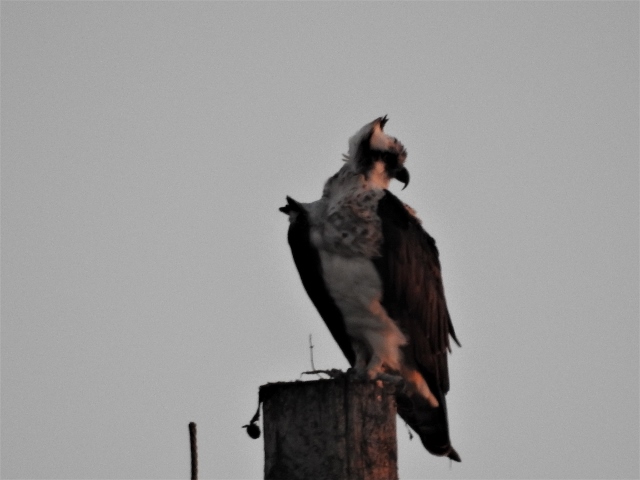by M. Kathy Raines

Its upper bill a massive catclaw, its gaze penetrating, the perching osprey swiveled as it scoured the Laguna Madre for ripples and the glint of a fin. I’m glad I’m not a mullet, I thought.
The Valley hosts an everchanging array of birds— resident populations, summer nesters, the flux of charming spring and autumn migrants and winter visitors like white pelicans, anhinga and myriad hawks, including the ospreys that grace our waterways. If you see a raptor along the Laguna Madre, especially one revealing quite a bit of white, it is likely an osprey.
A large hawk whose wingspan may reach over five feet, an osprey has a bushy crest and a white crown, forehead, neck, breast and belly. Its back and wings are dark brown. Intersecting its bright yellow eyes is a wide brown stripe, which, like an athlete’s undereye blacking, likely reduces glare off sparkling water. Its cere—the skin around its beak—and long, powerful legs are bluish gray. The larger female bears the hint of a brown necklace, while a youth has a creamy breast, orangish eyes and a white-spotted back.
This perfectly designed angler eats 99% fish. An osprey, like an owl, bears a reversible outer toe. With two talons pointing frontward and two back, the osprey manipulates a fish so that it points forward during flight, making the osprey, with its now stabilized prey, more aerodynamic. Sharp spicules, or scales, on talon surfaces help it grip slippery fish. An osprey’s dense, oily feathers repel weighty, flight-hindering water. Its strongly hooked, overhanging upper bill easily punctures tough fish skin.
The osprey (Pandion haliaetus) alone occupies the family Pandionidae, named for a mythical Athenian king whose daughters were transformed into birds. “Haliaetus”, meaning “sea eagle”, derives from the Greek words “halos” for sea and “aetos” for eagle. The name “osprey”, from Latin “ossifragus” or “bone breaker”, is based on a misunderstanding. Ospreys, unlike the lammergeier, an Old World vulture, does not drop and break bones. An osprey does, however, carry an occasional bone, along with other refuse, to its nest.
A successful, adaptable hawk, the osprey, with its four subspecies, occupies every continent except Antarctica and breeds or winters in most parts of North America.
Javier Gonzalez, Naturalist Educator at South Padre Island Birding, Nature Center and Alligator Sanctuary, said, “We see dozens around the Island and at least four close to the birding center every winter.” Ospreys also fish in the freshwater of nearby resacas, as well as in the Gulf when fish school near the surface.
A hovering osprey folds its wings to accelerate, then plummets, talons first, as deep as three feet. Its nostrils automatically close as it disappears underwater until it resurfaces, clutching a fish. Then, swinging it around to face forward, the osprey launches itself from the water’s surface, vigorously shaking off water. The osprey beats its wings rapidly to combat turbulence and the drag of the weighty fish plus its own now extended legs. It carries the fish to a perch, where, with a razor-sharp bill, it slices it into edible chunks.
An osprey, which has excellent vision and timing, adjusts its plunge both to its prey and the water depth, taking longer, lower dives into the shallows and steeper ones in greater depths. In wintertime, untroubled by nesting concerns, an osprey may opt to hunt from a perch, which demands more time but less energy.
An osprey, weighing about 3 ½ pounds, may carry off a fish more than double its weight, though most weigh less than a pound. The opportunistic osprey may also prey on amphibians, reptiles, birds and small rodents.
Research reveals that ospreys catch fish at least once for every four dives. Its dive is not without risk; it may be pulled under by a large fish. Also, bald eagles, in an act of kleptoparasitism, may steal prey from ospreys’ talons or harass them until they drop it.
Though ospreys live year-round in subtropical Florida, no nesting pairs have been seen here since the early 1900s. Gonzalez said, “I’m not sure why they don’t breed in our area,” adding that a few remain in the summer, “likely juveniles that are not going to nest.” In North America, ospreys breed in Canada and northern and northwestern states, as well as along the Atlantic and Pacific.
Ospreys build bulky nests in high branches, manmade structures and cliffsides. Besides sticks, seaweed and clumps of grass, a nest may contain items as disparate as flip-flops, flattened beach balls, strands from beach chairs, dirt, dung, animal skulls and, unfortunately, fishing line and strips of feet-entangling plastic.
Ospreys fiercely defend their nests, scolding people and attacking nearby birds. Nevertheless, sparrows and martins may nest underneath, presumably for the protection ospreys offer from nest-robbers.
Both sexes, but mainly the female, incubate the usual two to four eggs. Eggs don’t hatch all at once, with one nestling appearing perhaps five days earlier than the last. The older chick dominates, and the youngest may starve during tough times. Eggs hatch in about 38 days, with young fledging in from 51 to 55 days.
Ospreys tend to be solitary but may roost with from six to ten others. Their cries are chirps and a series of high whistles, whiew whiew and sheeap. They also call a shrill kyew kyew kyew.
An osprey flies slowly and steadily, holding its wings in a gull-like fashion with wrists forward and above their bodies and wingtips down and back, making what appears to be an M-shape from below.
Ospreys demonstrate little fear of humans, which operators of fish hatcheries may find problematic.
Ospreys are thriving, in spite of the serious decline they, along with other species, faced in the 1950s through 1970s until most countries banned the insecticide DDT, which weakened shells to such an extent that they fractured under the weight of nesting parents. Like all birds, ospreys require protection from chemicals, plastics and other pollutants.

